

Occupation (protest) As an act of protest, occupation is the entry into and holding of a building, space or symbolic site.
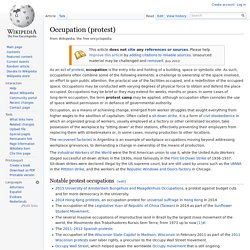
The Occupy movements have dramatised questions about public space: Who owns it? And who can use it? One year on, Richard Sennett reflects on the Occupy movements and the nature of public space.

He argues that the Occupiers not only changed the terms of debate about the current economic crisis, they also challenged urbanists to think about the city in new ways. Credit: Duncan (CC-BY-NC) via Flickr We are a year on from the Occupy movements of 2011, and like other participants I’ve been thinking about their legacy. In Spain, Greece, Britain and America relatively small numbers of protesters made a big noise about the evils of capitalism; to me, though, the movement’s lasting gift was embodied in the very word “occupy.” The protests occurred in spaces where people did not belong, taking place in plazas (New York), church steps (London), or shopping malls (Madrid) where protesters had no right to assemble. In America, in principle, there should be no public problem. The rights nations give, cities easily take away. London Protesters Turn Public Space into Civic Space. Polis recently featured a quote from James Holston in which he called for reactivation of the "social imagination" in using spaces of insurgent citizenship to generate alternative future political, economic and social structures.

Delphine-pages-el-karouis-mapping-the-arab-uprising. Wall Street Protest Shows Power of Place. Dispatch__ The ‘Occupy’ Movement: Emerging Protest Forms and Contested Urban Spaces. By Judy Lubin Abstract The Occupy Movement represents the evolving nature of contemporary social movements.
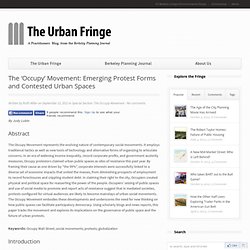
It employs traditional tactics as well as new tools of technology and alternative forms of organizing to articulate concerns. In an era of widening income inequality, record corporate profits, and government austerity measures, Occupy protestors claimed urban public spaces as sites of resistance this past year. By framing their cause as one driven by “the 99%”, corporate interests were successfully linked to a diverse set of economic impacts that united the masses, from diminishing prospects of employment to record foreclosures and crippling student debt. Keywords: Occupy Wall Street; social movements; protests; globalization Introduction On September 17, 2011, nearly a thousand protestors flooded New York City’s Zuccotti Park in a planned action against corporate power, political corruption, and economic inequality (Mitchell 2011).
Designing protests in urban public space. “Whatever happens in Tahrir immediately becomes a national concern,” the national daily Al-Ahram’s Fatemah Farag wrote in 1999, [1] making it clear that the location and the design of recent protests play a crucial role in the meaning and effect of the action on the general public.
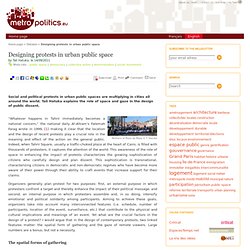
Indeed, when Tahrir Square, usually a traffic-choked plaza at the heart of Cairo, is filled with thousands of protesters, it captures the attention of the world. The Occupy Movement and the New Public Space - Politics. Governments are trying to figure out what to do with the Occupy movement that’s moved into public spaces in major cities all over the world.

Some have figured out only as much as getting them out of there; mayors from Oakland to New York have evoked concerns about public safety, sanitation, and good old law and order to justify forced evictions of campsites. Occupy Archive. Privately Owned Public Spaces and the Occupy Wall Street Protests. Additional reporting by Janos Marton, Michelle Young and Priyanka Jain.

Before (and After) the ‘Arab Spring’: From Connectedness to Mobilization in the Public Sphere. Oriente Moderno , XCI, 2011, 1, p. 5-12 Istituto per l’Oriente Carlo Alfonso Nallino – Roma.
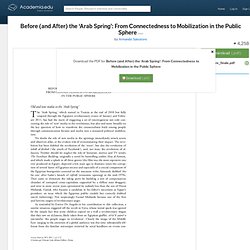
Map of the Arab Spring Protests on Tripline. Everyday_problem. Lefebvre_space_everyday. Challenge. Virginia_woolf_intro. The London Riots and the Right to the City. This was originally written in August, just after the London riots.

I also contacted Peter Marcuse to see if he would right something about the riots and the Right to the City for my work blog but I heard nothing back so I’ve had to attempt it myself! In the height of summer, Britain’s cities have been on the firing line of a struggle for urban power. Attacking the built environment is the most direct way to get attention and interrupt daily life and, as history shows us, it is generally used as a last resort when issues reach boiling point. Some argue that this attack on private property and also public space been an outlet for those excluded citizens whose voices are not being heard. Others say that looters feel they have a right to take things as they have nothing to lose.
“The right to the city is far more than the individual liberty to access urban resources: it is a right to change ourselves by changing the city. Like this: Like Loading... Ordering Space in a Post-Capitalist World: Henri Lefebvre’s The Production of Space. What would a society that moves beyond capitalism towards a humanitarian or egalitarian space look like?
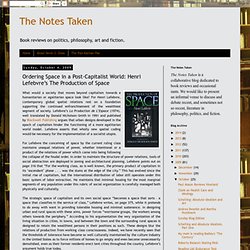
Antipode%20Lefebvre.